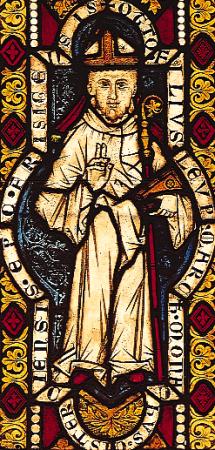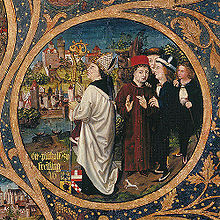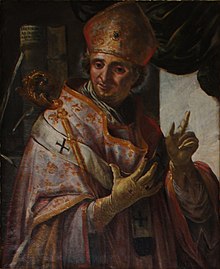Otto von Freising
Otto von Freising , also Otto I of Austria (* around 1112 probably in Klosterneuburg near Vienna ; † September 22, 1158 in the Cistercian monastery Morimond in France ), had been Bishop of Freising since 1138 and one of the most important historians of the Middle Ages .

Life

Otto von Freising was born around 1112 as the fifth son of the holy Babenberger Leopold III. , Margrave of Austria, and the daughter of Emperor Heinrich IV , Agnes von Waiblingen . Among his brothers were Leopold IV , Duke of Bavaria, Heinrich II , Duke of Austria, and Conrad II , Archbishop of Salzburg . His half-brother was King Konrad III. Otto was also an uncle of Emperor Friedrich Barbarossa .
He received his first training in the monastery of Klosterneuburg , which his father founded in 1114. In 1126 he was appointed provost of the monastery . In the same or the next year Otto went to study in France, above all in Paris , which had established itself as the center of the then new scholasticism (in contrast to the common monasticism ). Otto spent six years there listening to Peter Abelard , Hugo von St. Viktor and Gilbert de la Porrée .
In 1132 he joined the Cistercian order together with 15 German classmates, some of whom were high-born, and came as a novice to the Morimond monastery in Champagne . Six years later, in 1138, as a 26-year-old monk, he was elected abbot . But the next day he received from King Konrad III. appointed Bishop of Freising and from then on endeavored to renew church life in his diocese and its monasteries, of which he gave a new order to Schäftlarn ( Premonstratensians ), Schlehdorf ( Augustinian canons ) and Innichen ( Benedictines ). He freed the Freising Cathedral from the oppressive secular bailiwick , he led the cathedral school to a considerable importance. He re-founded the Schliersee (collegiate monastery) and Neustift (Premonstratensian) monasteries near Freising. Strangely enough, however, these were not Cistercian monasteries.
During the investiture controversy, he almost inevitably came into conflict with the Wittelsbachers , but because of his imperial relatives he successfully mediated the disputes between the Hohenstaufen , Babenbergs and Guelphs . At the request of Bernhard von Clairvaux , he also took an active part in the Second Crusade as a spiritual prince , but at the end of the crusade he only managed to escape with a small group of loyal followers. On behalf of Konrad III. he was also diplomatically active: Among other things, he made three trips to Rome , under Emperor Friedrich Barbarossa he was involved in the settlement of the dispute with Pope Hadrian IV . His ideal, also in piety, was moderation. Bernhard von Clairvaux remained deeply foreign to him throughout his life.
In 1157 Otto was officially commissioned by Emperor Friedrich Barbarossa to record the emperor's deeds ( Gesta Friderici Imperatoris ). Otto could no longer complete his work. He died on September 22, 1158 on the way to the General Chapter in Cîteaux in his former monastery Morimond . Otto was first buried in the monastery church of Morimond. Up until the 17th century, Otto von Freising's grave was raised above the ground and freely visible in front of the high altar there .
Today there is a reliquary with bones that are believed to be those of the Blessed, under the high altar in the collegiate church of Heiligenkreuz in the Vienna Woods .
plant
In the history of philosophy Otto von Freising is considered to be one of the first to bring the new Aristotle to Germany. Only fragments of his literary work have survived. His philosophical writings and his correspondence were lost. As a Cistercian Otto was closely connected to the religious ideals and the intellectual world of his epoch; as a historian he created the outstanding works of early Staufer historiography . Due to his kinship with the imperial family, he was given a special insight into history and politics that was only given to a few of his contemporaries. Thus Otto is considered one of the greatest historians of the high Middle Ages .
His first work, the Chronica sive Historia de duabus civitatibus , d. H. The history of the two states is based on the work De civitate Dei by the church father Augustine of Hippo . It is a world history in 7 books, in the 8th book Otto unfolds his vision of the Last Judgment . Otto wrote this work between 1132 and 1146 and revised it again in 1157. The work became the high point of historiography in the Middle Ages: It is dedicated to the transformation of Augustinian and Platonic ideas, especially the two-state theory. The focus is on the world empires, which like all culture migrate from east to west and find their final form in the Roman Empire until the end of the world. It is crucial that the Ecclesia Christi connects with the Imperium Romanum and thus becomes the Civitas Dei , the perfect harmony of spiritual and worldly power. In contrast to that of St. Augustine , the Civitas Dei thus experiences a realization on earth. The meaning of the work lies in its historical-theological dimension, which Augustine 's doctrine of the two civitates clearly expands. A picture cycle conceived in the 12th century has survived in two early copies of the text.
Around 1156 Otto began the Gesta Friderici Imperatoris , d. H. The deeds of his nephew Emperor Friedrich Barbarossa . Under the impression of the hopeful government of the emperor, he wrote the first two books: Book 1 deals with the time from Heinrich IV. To Conrad III. , in contrast to the view in the Chronicon interpreted as the time of preparation for the coming imperial power under Friedrich Barbarossa. Book 2 describes Barbarossa's story from 1152 to 1158. Otto used here, partly literally, partly exclusively, many imperial files as a source . Otto could only finish the first two volumes. Even before his death (1158) he had wisely commissioned his student Rahewin to complete his work. Rahewin wrote the third and fourth volumes. Another successor was Otto von St. Blasien .
The Gesta are less deeply thought-provoking in terms of the philosophy of history, but convey the most vivid characteristics of personalities of church history, including Abelard and Arnold von Brescia . With regard to Barbarossa, the text is not free of subjective formulations. The presentation of the Hohenstaufen in particular is clearly linked to an objective that - in modern terms - could be called propagandistic. Otto wanted to portray the Staufen house in a light that predestined it to fulfill the divine will.
Trivia
Otto von Freising rates Bishop Hartwig von Regensburg as Hartwicus Ratisponensis episcopus inutilis .
Adoration
Otto has long been venerated as a blessed in the Cistercian order. His feast day in the Archdiocese of Vienna and in the Archdiocese of Munich-Freising has been September 7th with the approval of the Roman Congregation for Rites since 1973. A statue of the Blessed is in Freising Cathedral. Under the sacramental altar of the abbey church of the Cistercian Abbey of Heiligenkreuz there is a reliquary that is said to contain the bones of the blessed. A relic of Blessed Otto was placed in the celebration altar of St. Kastulus Minster in Moosburg . In 1995 a memorial stele was erected for him on the site of the former Morimond monastery . A bridge figure reminds of him on the Korbinian Bridge in Freising. He is often depicted in church windows, mostly as a writing bishop, such as in the Liesing parish church and the Otto von Freising chapel in Gaaden .
It is noteworthy that this blessed one enjoys greater veneration among historians and German scholars than among the Catholic people of his homeland. In this context, a memorial plaque dedicated to Blessed Otto was created in the Walhalla near Regensburg .
Text output
Critical Editions
- Adolf Hofmeister (ed.): Scriptores rerum Germanicarum in usum scholarum separatim editi 45: Ottonis episcopi Frisingensis Chronica sive Historia de duabus civitatibus. Hanover 1912 ( Monumenta Germaniae Historica , digitized version )
- Georg Waitz and Bernhard von Simson (eds.): Scriptores rerum Germanicarum in usum scholarum separately in editi 46: Ottonis et Rahewini Gesta Friderici I. imperatoris. Hanover 1912 ( Monumenta Germaniae Historica , digitized version )
Translations
- Otto Bishop of Freising: Chronicle or the history of the two states (= selected sources on the German history of the Middle Ages. Vol. 16). Translated by Adolf Schmidt, edited by Walther Lammers. 4th edition. Wissenschaftliche Buchgesellschaft, Darmstadt 1980, ISBN 3-534-00174-5 (Latin / German).
- Bishop Otto von Freising and Rahewin: The deeds of Friedrich or more correctly Cronica (= selected sources on German history of the Middle Ages. Vol. 17). Translated by Adolf Schmidt, edited by Franz-Josef Schmale . 4th edition, extended by a supplement by Fabian Schwarzbauer compared to the 3rd. Scientific Book Society, Darmstadt 2000, ISBN 3-534-01418-9 (Latin / German).
literature
- Roman Deutinger : Otto von Freising. In: Katharina Weigand (ed.): Great figures of Bavarian history. Herbert Utz Verlag, Munich 2011, ISBN 978-3-8316-0949-9 , pp. 51-71.
- Joachim Ehlers : Otto von Freising. An intellectual in the Middle Ages. A biography. Beck, Munich 2013, ISBN 978-3-406-65478-7 .
- Hans-Werner Goetz : Otto's view of history from Freising. A contribution to the historical world of imagination and the history of the 12th century (= Archive for Cultural History. Supplements. Vol. 19). Böhlau, Cologne et al. 1984, ISBN 3-412-05983-8 (also: Bochum, University, habilitation thesis, 1983)
- Ulrike Götz (eds.): Otto von Freising, Rahewin, Conradus sacrista. Historian of the 12th century in Freising. Contributions to the 850th year of the death of Bishop Otto von Freising in 2008 (= collective sheet of the historical association Freising. Vol. 41). Historical Association, Freising 2010, ISBN 978-3-00-031024-9 .
- Hans-Werner Goetz: Otto von Freising. In: New German Biography (NDB). Volume 19, Duncker & Humblot, Berlin 1999, ISBN 3-428-00200-8 , pp. 684-686 ( digitized version ).
- Cornelia Kirchner-Feyerabend: Otto von Freising as diocesan and imperial bishop , Frankfurt am Main 1990, ISBN 3-631-42408-6 .
- Franz Nagel: The world chronicle of Otto von Freising and the visual culture of the high Middle Ages. Tectum, Marburg 2012, ISBN 978-3-8288-2876-6 .
- U. Schmidt: Otto von Freising. In: Biographisch-Bibliographisches Kirchenlexikon (BBKL). Volume 6, Bautz, Herzberg 1993, ISBN 3-88309-044-1 , Sp. 1373-1375.
Web links
- Literature by and about Otto von Freising in the catalog of the German National Library
- Otto episcopus Frisingensis in the repertory "Historical Sources of the German Middle Ages"
- Entry on Otto von Freising in the Austria Forum (in the AEIOU Austria Lexicon )
- Entry on Otto von Freising in the database of the state's memory for the history of the state of Lower Austria ( Museum Niederösterreich )
- Otto von Freising in the Biographia Cisterciensis
- Otto Frisingensis: Chronica sive Historia de duabus civitatibus - BSB Clm 1003 - digitized version of the work in bavarikon
- W. Robl: Excerpt from the Gesta Friderici
- Pius Maurer: Otto von Freising in Biographia Cisterciensis (Cistercian Biography)
- Otto von Freising: Gesta Friderici
Remarks
- ^ Leopold Grill : Result of the search for Otto von Freising's grave, in: Annalen des Naturhistorisches Museum 77 (1973), pp. 421–424.
- ↑ Cf. Franz Nagel: The World Chronicle of Otto von Freising and the Image Culture of the High Middle Ages, Marburg 2012.
- ^ Otto von Freising, Gesta Friderici Imperatoris, Liber IV
- ↑ Archdiocese of Vienna, Directory (PDF file; 2.6 MB)
- ↑ Peter Pfister and Friedrich Wetter : Your friends of God all too equal. Saints and Blessed in the Archdiocese of Munich and Freising, Munich 2003, p. 122.
| predecessor | Office | successor |
|---|---|---|
| Heinrich I. |
Bishop of Freising 1138–1158 |
Albert I of Harthausen |
| personal data | |
|---|---|
| SURNAME | Otto von Freising |
| ALTERNATIVE NAMES | Otto of Austria |
| BRIEF DESCRIPTION | Bishop of Freising; Historian |
| DATE OF BIRTH | around 1112 |
| PLACE OF BIRTH | Klosterneuburg near Vienna (uncertain) |
| DATE OF DEATH | September 22, 1158 |
| Place of death | Morimond Monastery |



